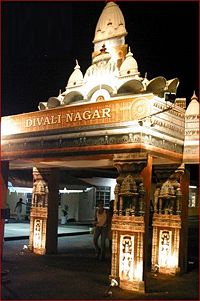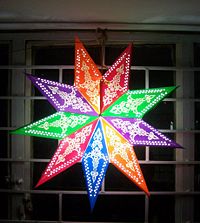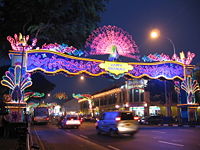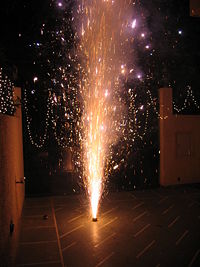Diwali
| Diwali | |
|---|---|
| Diwali | |
| For Hindus, Diwali is not only a festival of lights but also a special occasion to worship Lord Ganesha, Goddess Lakshmi and Lord Mahabali. For Jains, it is an occasion to remember Lord Mahavira. | |
| Also called | Translation: Row of Lights; Deepavali, Festival of Lights |
| Observed by | Religiously by Hindus, Sikhs and Jains. Other Indians celebrate the cultural aspects. |
| Type | Religious, Indian |
| Significance | Celebrate life and strengthen relationships |
| Date | New moon day of Kartika, although the celebrations begin two days prior and end two days after that date |
| Celebrations | Decorating homes with lights, Fireworks, Gift-giving |
| Observances | Prayers, Religious rituals (see puja, prasad) |
Diwali, also called Deepavali (Sanskrit: दीपावली) is a major Hindu festival that is very significant in Hinduism, Sikhism and Jainism. Known as the "Festival of Lights," it symbolises the victory of good over evil, and lamps are lit as a sign of celebration and hope for mankind. Celebrations focus on lights and lamps, particularly traditional diyas (as illustrated). Fireworks are associated with the festival in many regions of India.
Diwali is the name used by North Indians for the festivals while South Indians call it Deepavali. However, both names literally translated mean the same, which is "row of lights".
Diwali is celebrated for five consecutive days at the end of Hindu month of Ashwayuja. It usually occurs in October/November, and is one of the most popular and eagerly awaited festivals in India. Diwali comes exactly twenty days after Dussehra. Hindus, and Sikhs alike regard it as a celebration of life and use the occasion to strengthen family and social relationships. For Hindus it is one of the most important festivals, and beginning of the Hindu year. Hindus celebrate Diwali to mark the time when Lord Ram achieved victory beating Ravana. It is also a significant festival for the Sikh faith.
Dates in various calendars
The festival is worshipped on exactly the same set of days across India. It falls in different months depending on the version of the Hindu calendar being used in the given region.
The Amantnm ("ending on the no-moon") version of the Hindu Calendar has been adopted as the Indian national calendar. According to this calendar, which is prevalent in southern India and Maharashtra, Deepavali falls in the middle of the month of Ashwayuja. According to the Purnimanta ("ending on the full-moon") version prevalent in northern India, the 5-day celebration is spread over the last three days of the month of Ashwayuja and the first two days of the new month of Kartika. According to this calendar, the festival of Deepavali marks the new year's day and is therefore an especially significant festival.
In the Gregorian calendar, it falls generally in the months of October or November. In 2006, it was celebrated on October 21 (Saturday).
Significance in Hinduism
| Year | Date |
|---|---|
| 2005 | November 1 |
| 2006 | October 21 |
| 2007 | November 9 |
| 2008 | October 28 |
| 2009 | October 17 |
| 2010 | November 5 |
| 2011 | October 26 |
| 2012 | November 13 |
| 2013 | November 3 |
| 2014 | October 23 |
| 2015 | November 11 |
| 2016 | October 30 |
| 2017 | October 19 |
| 2018 | November 7 |
| 2019 | October 27 |
| 2020 | November 14 |
The festival marks the victory of good over evil. The Sanskrit word Deepavali means an array of lights that stands for victory of brightness over darkness. As the knowledge of Sanskrit diminished, the name was popularly modified to Diwali, especially in northern India. In South India, Diwali does not coincide with the beginning of a new year as South Indians follow a different calendar, the Shalivahana calendar.
On the day of Diwali, many wear new clothes, share sweets and snacks, and light firecrackers. The North Indian business community usually starts their financial new year on Diwali and new account books are opened on this day.
Hindus find cause to celebrate this festival for different reasons:
- It commemorates the killing of Narakasura, an evil demon who created havoc, by Lord Krishna's wife Sathyabhama. This happened in the Dwapara Yuga during this time of Lord Krishna's avatar. In another version, the demon was killed by Lord Krishna himself. Before Narakasura's death, he requested a boon from his mother, Sathyabhama, that everyone should celebrate his death with colorful light .
- According to the Skanda Purana, the goddess Shakti observed 21 days of austerity starting from ashtami of shukla paksha (eighth day of the waxing period of moon) to get half of the body of Lord Shiva. This vrata (austerity) is known as kedhara vrata. Deepavali is the completion day of this austerity. This is the day Lord Shiva accepted Shakti into the left half of the form and appeared as Ardhanarishvara. The ardent devotees observe this 21 days vrata by making a kalasha with 21 threads on it and 21 types of offerings for 35 days. The final day is celebrated as kedhara gauri vrata.
- Diwali also celebrates the return of Lord Rama, King of Ayodhya, with his wife Sita and brother Lakshmana to Ayodhya from a war in which he killed the demon king Ravana. It is believed that the people lit oil lamps along the way to light their path in the darkness. This is the reason, why the festival is celebrated a day earlier in South India since Lord Rama travelled from the south to his kingdom in the north. In North India, the festival is held on the final day of the Vikram calendar. The following day marks the beginning of the North Indian new year, and is called Annakut.
- In Bhavishyottara and Bramhavaivarta Purana, Diwali is associated with the Daitya king Bali, who is allowed to return to earth once a year.
Esoteric Significance
While Deepavali is popularly known as the "festival of lights", the most significant esoteric meaning is "the awareness of the inner light".
Central to Hindu philosophy, is the assertion that there is something beyond the physical body and mind which is pure, infinite, and eternal, called the Atman. Just as we celebrate the birth of our physical being, Deepavali is the celebration of this Inner Light, in particular the knowing of which outshines all darkness (removes all obstacles and dispels all ignorance), awakening the individual to ones true nature, not as the body, but as the unchanging, infinite, immanent and transcendent reality. With the realization of the Atman, comes universal compassion, love, and the awareness of the oneness of all things (higher knowledge). This brings Ananda (Inner Joy or Peace).
Deepavali celebrates this through festive fireworks, lights, flowers, sharing sweets, and worship. While the story behind Deepavali varies from region to region, the essence is the same - to rejoice in the Inner Light (Atman) or the underlying reality of all things (Brahman).
The Five days of Diwali
Diwali is celebrated over five days in most of North India. All the days except Diwali are named using the designation in the Indian calendar. A lunar half-month is 15 days. Diwali as a new-moon day, marks the last day of a 15-day period.
- Dhan-trayodashi or Dhan teras: Dhan means "wealth" and Trayodashi means "13th day". Thus, as the name implies, this day falls on the 13th day of the first half of the lunar month. It is an auspicious day for shopping (Gujarati: Dhan Teras).
- Naraka Chaturdasi: Narak means 'of a new era of Light and Knowledge'. Chaturdasi implies fourteenth day (Gujarati: Kali Chaudas).
- Diwali: the actual day of Diwali, is celebrated on the third day of the festival, when the moon completely wanes and total darkness sets in the night sky.
- Varsha-pratipada or Padwa: Beginning of the New Year (Kartikadi Vikram). Pratipada means the first (Gujarati: Bestu Varas).
- Bhayiduj (also Bhayyaduj, Bhaubeej or Bhayitika) — on this day, brothers and sisters meet to express their love and affection for each other (Gujarati: Bhai Bij, Bengali: Bhai Phota).
The celebrations vary in different regions:
- In Southern India, naraka chaturdashii is the main day, with firecrackers at dawn.
- The main festival is on Amavasya evening with Lakshmi Puja which is followed by lighting of oil lamps around the house.
Lakshmi Puja
As per spiritual references, on this day 'Lakshmi-panchayatan' enters the Universe. Sri Vishnu, Sri Indra, Sri Kuber, Sri Gajendra and Sri Lakshmi are elements of this 'panchayatan' (a group of five).
The tasks of these elements are:
- Vishnu: Happiness (happiness and satisfaction)
- Indra: Opulence (satisfaction due to wealth)
- Kuber: Wealth (one who gives away wealth)
- Gajendra: Carries the wealth
- Lakshmi: Divine Energy (Shakti) which provides energy to all the above activities.
Importance of Lakshmi Puja
- Destruction of distressing energies: On this particular day, Goddess Lakshmi's destroyer (marak) form is active, since it is the new moon day. The spiritual emotion of the person doing ritualistic worship, activates Goddess Lakshmi's marak form and destroys the distressing frequencies in the environment.
- Arrival of other Gods (Devtas): Lord Indra and other male deities also get drawn to the place of ritualistic worship and follow Goddess Lakshmi. Thus happiness, opulence, prosperity, stability and wealth is maintained in the premise (Vastu) by worshiping the 5 elements or Deities[2]
Diwali in Sikhism
Sikhs celebrate Diwali to commemorate the laying of the foundation stone for the Golden Temple in 1577. It is also known as Bandi Chhorh Divas. The Mughal emperor Jahangir arrested the Sikh Guru Hargobind and imprisoned him in Gwalior with 52 kings. Later Jehangir relented and released the Guru. The Guru asked that 52 rulers imprisoned with him should also be released. To the joy of the Sikhs the Guru returned to Amritsar on Diwali and it prompted the followers to celebrate the day with joy and happiness.
On Diwali the Sikhs illuminate their Gurdwaras and homesare with Deewé (earthen oil lamps) or candles. Early in the morning, Sikh pilgrims take a dip in the sacred tank while reciting Japji Sahib, and then pray at the Golden Temple. Circumambulation of the tank is done.
Diwali in Jainism
Lord Mahavira, the last of the Jain Tirthankaras, attained Nirvana on this day at Pavapuri. According to Jain tradition the chief disciple of Mahavira, Ganadhar Gautam Swami also attained complete knowledge (Kevalgyana) on this very day, thus making Diwali a really special occasion for the Jains to celebrate.
Diwali is first mentioned in Jain books as the date of the nirvana of Lord Mahavira. The oldest use of the word "Diwali/Dipavali" occurs in Harivamsha-Purana written by Acharya Jinasena, composed in Shaka Samvat 705. The sample of text containing the word Diwali is below:
ज्वलत्प्रदीपालिकया पृव्रद्ध्या सुरासुरैः दिपितया प्रदीप्तया| तदा स्म पावानगरी समन्ततः प्रदिपिताकाशतला प्रकाशते |१९|
ततस्तुः लोकः प्रतिवर्षमादरत् प्रसिद्धदीपलिकयात्र भारते | समुद्यतः पूजयितुं जिनेश्वरं जिनेन्द्र-निर्वाण विभूति-भक्तिभाक् |२० |
Thus people in Bharata every year celebrate famous "Dipalikaya", to reverently worship the Jinendra on the occasion of his nirvana on the amavasya of Kartika month.
Significance of lamps: The Kalpasutra by Acharya Bhadrabahu, 3rd century B.C.E., explains the significance of lights: "गये से भवुज्जोये, दव्वुज्जोयं करिस्समो", with light of knowledge gone, we make light of ordinary matter.
The way Jains celebrate Diwali is different in many respects. There is a note of asceticism in whatever the Jains do, and the celebration of Diwali is not an exception. The Jains celebrate Diwali during the month of Kartik for three days. During this period, among the Shvetambaras, devoted Jains observe fasting and chant the Uttaradhyayan Sutra, which contain the final pravachans of Lord Mahavira, and meditate upon him.
Vira Nirvana Samvat: The Jain year starts with Pratipada following Diwali. Vira Nirvana Samvat 2532 starts with Diwali 2005. The Jain businessmen traditionally started their accounting year from Diwali.
Melas
To add to the festival of Diwali, fairs called Melas are held throughout India.[3] Melas are to be found in many towns and villages. A mela generally becomes a market day in the countryside when farmers buy and sell produce. Girls and women dress attractively during the festival. They wear colourful clothing, new jewelry and their hands are decorated with henna designs.
Among the many activities that take place at a mela are performances by jugglers, acrobats, snake charmers and fortune tellers. Food stalls are set up, selling sweet and spicy foods. There are a variety of rides at the fair, which include Ferris wheels and rides on animals such as elephants and camels. Another attraction is the puppet shows that are shown throughout the day.
Diwali in other parts of the world

Diwali is celebrated in various parts of the world, in countries such as the United Kingdom, the Netherlands, Suriname, Canada, Guyana, Mauritius, India, Fiji, Japan, Indonesia, Malaysia, Myanmar, Nepal, Singapore, Sri Lanka, South Africa, Trinidad and Tobago, Thailand, United Arab Emirates, Australia, much of Africa, and the United States.[4] With more and more Indians and Sri Lankans now migrating to various parts of the world, the number of countries where Diwali is celebrated has been gradually increasing. While in some countries it is celebrated mainly by Indian expatriates, in others it has become part of the general local culture. In most of these countries Diwali is celebrated on the same lines as described in this article with some minor variations. Some important variations are worth mentioning.
In Nepal, Diwali is known as "Tihar" and celebrated during the October/November period. Here the festival is celebrated for five days and the traditions vary from those followed in India. On the first day, cows are given offerings, in appreciation of the food they have given and agricultural work they have performed. On the second day, dogs and all living animals are revered and offered special food. On the third day, celebrations follow the same pattern as in India, with lights and lamps and much social activity. On the fourth day Yama, the Lord of Death, is worshipped and appeased. On the fifth and final day, brothers and sisters meet and exchange pleasantries.
In Trinidad and Tobago, communities all over the islands get together and celebrate the festival. One major celebration that stands out is the Divali Nagar, or Village of the Festival of Lights. It features stage performances by the east Indian cultural practitioners, a folk theatre featuring skits and plays, an exhibition on some aspect of Hinduism, displays by various Hindu religious sects and social organizations, nightly worship of Goddess Lakshmi, lighting of deeyas, performances by various schools related to Indian culture, and a food court with Indian and non-Indian vegetarian delicacies. The festival culminates with magnificent fireworks displays ushering in Diwali. Thousands of people participate in an atmosphere devoid of alcohol and in a true family environment.
In Malaysia, Diwali is known as "Hari Deepavali," and is celebrated during the seventh month of the Hindu solar calendar. It is a federal public holiday throughout Malaysia. In many respects it resembles the traditions followed in the Indian subcontinent. 'Open houses' are held where Hindu Malaysians welcome fellow Malaysians of different races and religions to their house for a sumptious meal. 'Open house' or 'rumah terbuka' is a practice very much unique to Malaysia and shows the goodwill and friendly ties practised by all Malaysians during any festive occasion.
In Singapore, the festival is called "Deepavali", and is a gazetted public holiday. Observed primarily by the minority Indian community, it is typically marked by a light-up in the Little India district and is most known for the fire-walking ceremonies not practiced as part of the festival in other countries. The Hindu Endowment Board of Singapore along with Singapores' government organizes many cultural events around Diwali time.
In Sri Lanka, this festival is also called "Deepavali" and is celebrated by the Tamil community. On this day, it is traditional for people to wear new clothes and exchange pleasantries.
Economics of Diwali
Diwali is an annual stimulus for the Indian economy. Indians purchase gold, gifts, decorations, crackers (fireworks) and household appliances during this festival and many Indian films (Bollywood, Tollywood, Kollywood, etc.) are released during this period. Companies offer huge discounts during the Diwali season to attract customers, which helps the economy and also helps the poor. Food distributed as acts of charity during community festivities also helps the underprivileged. Diwali also brings tourists to the country. Schools in India are closed during this festival, and many young people have the free time and the money to spend on luxury items. Also, people buy new clothes to wear during Diwali.
(See for comparison Economics of Christmas).
it is also a traditoin to dance it the streets
Diwali On The Office
Diwali took center stage on American television during an August 2006 episode of NBC's The Office during which the employees of the Dunder Mifflin Paper Company attended a Diwali party in Scranton, Pennsylvania with Kelly Kapour (Mindy Kaling), a fellow coworker of Indian extraction and a member of the Hindu faith. The episode also featured Michael Scott's (Steve Carell) rendition of the "Diwali Song", a parody of the Hanuka Song by Adam Sandler.
Notes
- ↑ Hindu Festivals till the end of year 2031. Retrieved 2006-01-23.
- ↑ Diwali Festival. hindujagruti.org. Retrieved 2006-10-20.
- ↑ Kadowala, Dilip (1998). Divali. London: Evans Brothers Limited. ISBN 0-237-51801-5.
- ↑ Diwali Celebrations Around The World. diwalifestival.org. Retrieved 2006-08-27.
External links
- Diwali - Details about various days, how to celebrate them, Campaign against fire crackers
- Hindustan Times Special
- Diwali - a Indian festival of light
- Diwali Pooja/Katha in Hindi
- Legends of Diwali
- Seven Different Views on Origin of Diwali
- Significance of Deepavali and Kedhara vrata
- Comprehensive guide to Diwali in India.
- BBC Diwali information
- Divali Nagar village in Trinidad and Tobago
- BBC: Personal report on Hindu Diwali celebrations in UK
- Diwali Rangolis, and Diwali Legends
- Diwali Celebration Pictures
| |||||||||||||
Credits
New World Encyclopedia writers and editors rewrote and completed the Wikipedia article in accordance with New World Encyclopedia standards. This article abides by terms of the Creative Commons CC-by-sa 3.0 License (CC-by-sa), which may be used and disseminated with proper attribution. Credit is due under the terms of this license that can reference both the New World Encyclopedia contributors and the selfless volunteer contributors of the Wikimedia Foundation. To cite this article click here for a list of acceptable citing formats.The history of earlier contributions by wikipedians is accessible to researchers here:
The history of this article since it was imported to New World Encyclopedia:
Note: Some restrictions may apply to use of individual images which are separately licensed.



